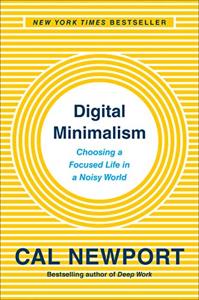
Want to learn the ideas in Digital Minimalism better than ever? Read the world’s #1 book summary of Digital Minimalism by Cal Newport here.
Read a brief 1-Page Summary or watch video summaries curated by our expert team. Note: this book guide is not affiliated with or endorsed by the publisher or author, and we always encourage you to purchase and read the full book.
Video Summaries of Digital Minimalism
We’ve scoured the Internet for the very best videos on Digital Minimalism, from high-quality videos summaries to interviews or commentary by Cal Newport.
1-Page Summary of Digital Minimalism
Overview
Technology has been the biggest influence in our lives for quite some time. One of the most important ones was the “Like” button, which started out on FriendFeed and is now used on every social media platform. This simple feature allows us to collect data about people’s preferences and behaviors, making it a great way to keep users hooked.
People are starting to realize that social media isn’t as great as they thought. In fact, research is showing us the many negative effects of social media and smartphones.
In this book, a professor conducted an experiment to learn about the effects of technology. He had 1,600 people commit to a month-long digital detox and asked them for feedback on their experiences. The result was that they found it easier to concentrate and be more productive. They also reported feeling happier and less stressed out because of it.
In this article, you’ll learn that social media is similar to big tobacco and how the Amish can help you use your smartphone better. You’ll also find out how valuable your attention has become compared to oil.
Big Idea #1: These days, devices intended for telephone calls and portable music have turned into addictive and dangerous tools.
New York magazine published a piece by Andrew Sullivan in 2016. In 7,000 words, the writer described how the constant barrage of news and online babble finally broke him. Readers who are familiar with this phenomenon will recognize the symptoms – an urge to check your texts, email or social media feeds at all times, a strange dull feeling when you’re not using digital media. How did we get here?
It’s important to realize that smartphones were never meant to be used as they are now. Steve Jobs introduced the first iPhone, and said it was “the best iPod ever.” It was mainly for making phone calls and listening to music. However, Andy Grignon says that Jobs didn’t think about third-party apps or gaming on the device.
In 2004, Facebook was not a major source of news. In fact, it wasn’t even very popular among college students. Instead, the computer strategy game Snood was more popular.
So, when people first started using iPhones and Facebook, they didn’t realize that those products would become addictive. They were designed to be addictive by social media engineers. In a 2017 episode of the HBO talk show Real Time, Bill Maher compared the social media tycoons to big tobacco companies because their products are deliberately designed to be as addicting as possible.
There have been many books written about the way people can get and keep someone’s attention. One of the most significant developments in this area is Facebook’s thumbs up button, which was introduced after FriendFeed’s “like” button. Now, when someone posts something on their wall or a group page, it becomes an interactive experience. How many people like my post? We constantly check to see if anyone has liked our post, and we’re finely attuned to sounds that accompany those responses.
Big Idea #2: Digital minimalism is based on the philosophy that less can be more.
If we want to protect ourselves against the people who are eager to take advantage of our weaknesses, we need a strong defense. Cal Newport proposes a lifestyle he calls digital minimalism. There are plenty of articles that recommend quick fixes like simply disabling notifications on your smartphone, but Newport doesn’t believe these little adjustments will make much difference in the long run. After all, one article said the author disabled 112 apps’ notifications and asked if you really needed so many apps anyway?





